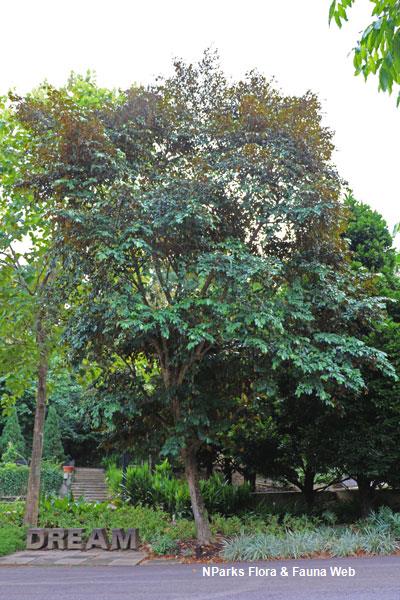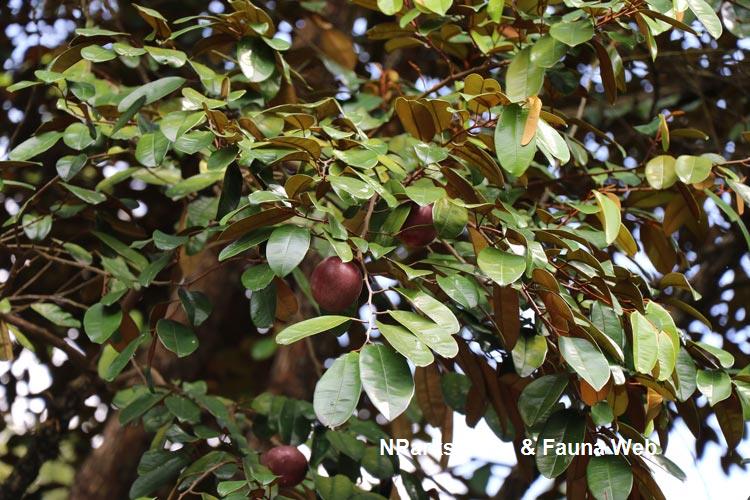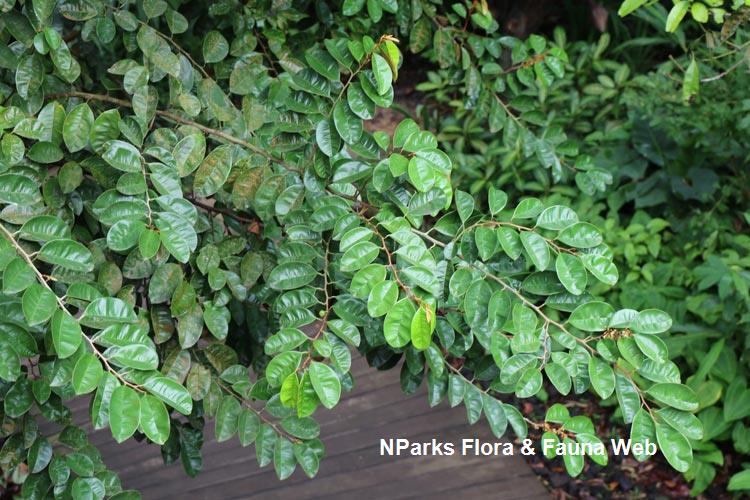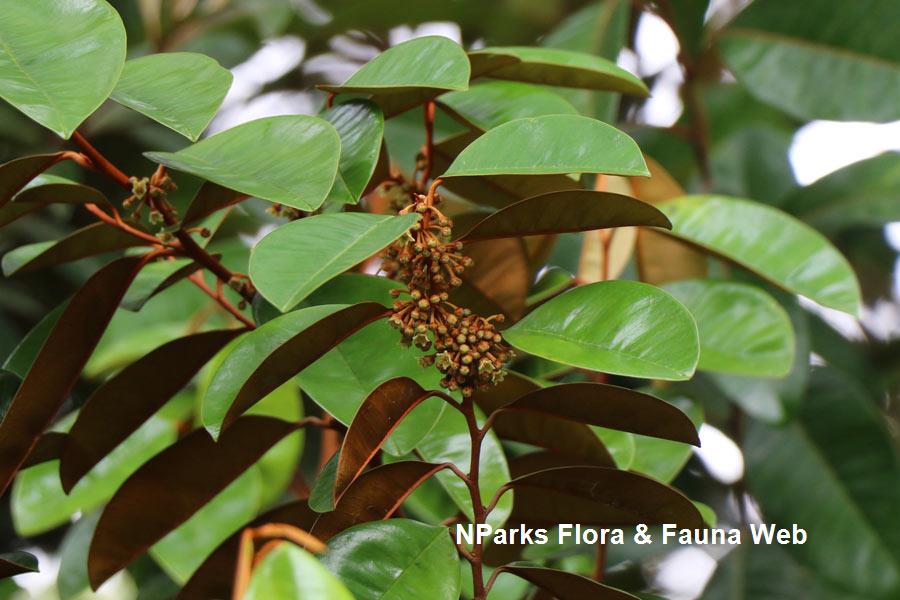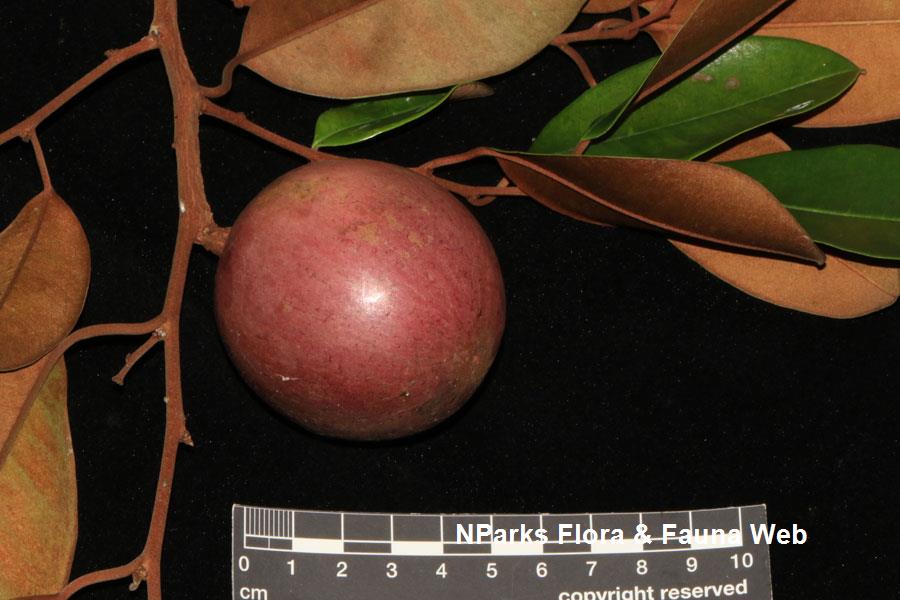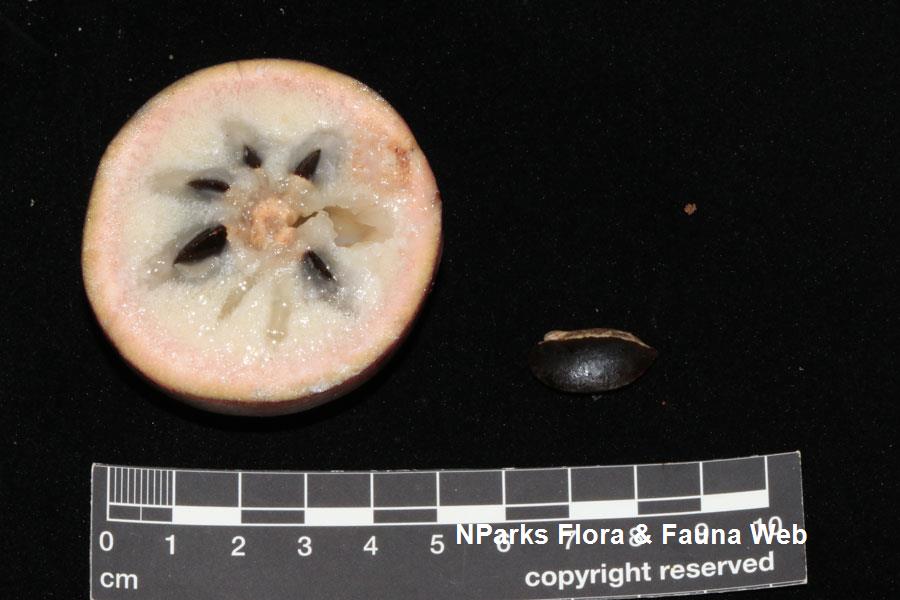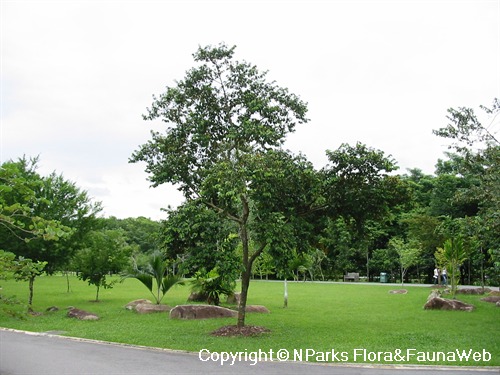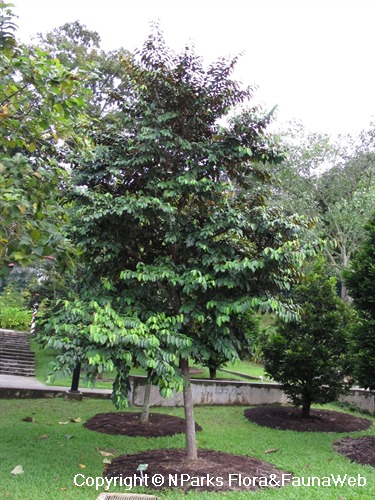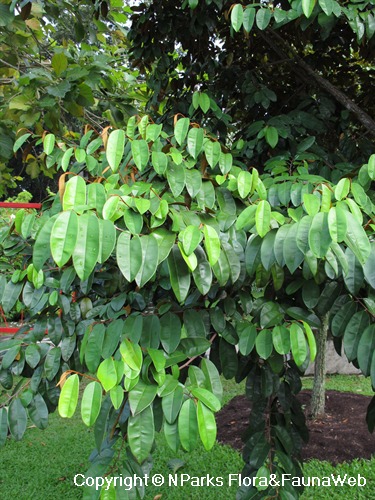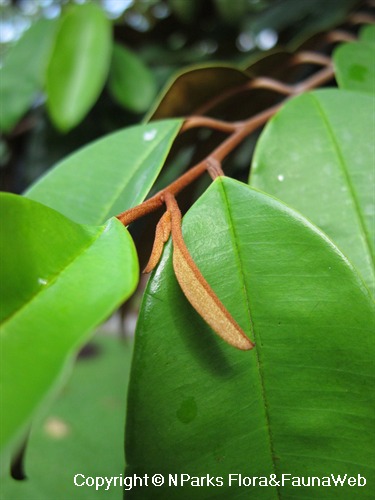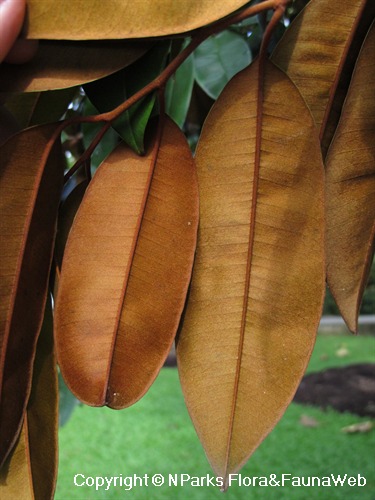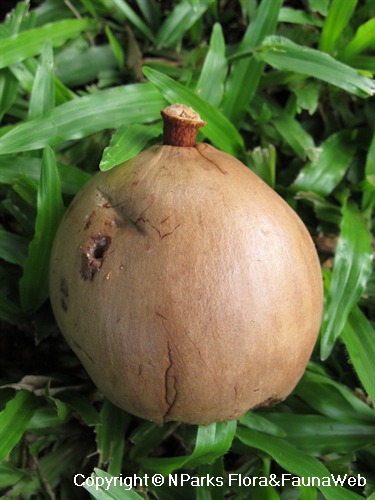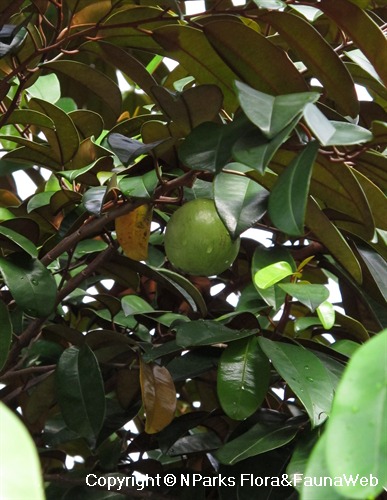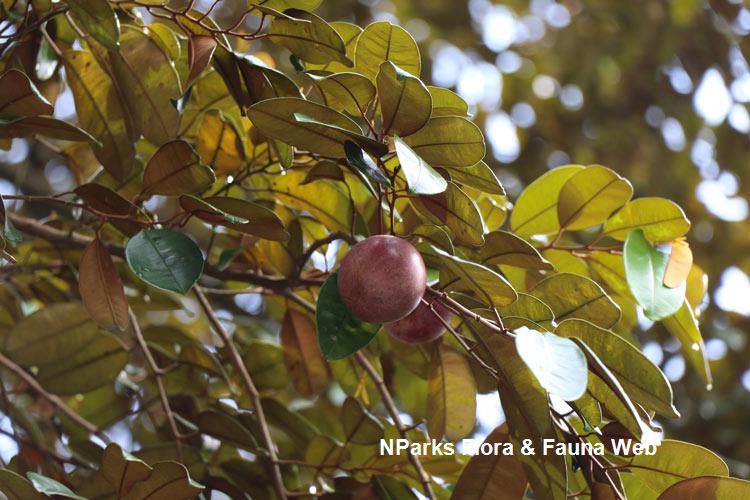
Back
Chrysophyllum cainito L.
| Family Name: | Sapotaceae |
| Synonyms: | Chrysophyllum monopyrenum Spreng., Chrysophyllum jamaicense Jacq. |
| Common Name: | Star Apple, Achras cainito, Cainito, Caimito |
Chrysophyllum caimito, commonly known as Star Apple, is a tree which usually reaches around 15 m tall in cultivation. Its leaves are ornamental, with a green upper surface and a striking golden-brown underside. The fruit ripens to purple and the juicy white pulp tastes sweet.
Name
Classifications and Characteristics
| Plant Division | Angiosperms (Flowering Seed Plants) |
|---|---|
| Plant Growth Form | Tree |
| Lifespan (in Singapore) | Perennial |
| Mode of Nutrition | Autotrophic |
| Maximum Height | 15 m |
Biogeography
| Native Distribution | Central America, Caribbean |
|---|---|
| Native Habitat | Terrestrial (Primary Rainforest) |
| Preferred Climate Zone | Tropical, Sub-Tropical / Monsoonal |
| Local Conservation Status | Non-native (Horticultural / Cultivated Only) |
Description and Ethnobotany
| Foliage | Leaves simple, oval to oblong in shape and alternate, either in two rows on opposite sides of the stem (= distichous) or spirally arranged, drooping. Upper lamina (= surface of the leaf) deep green, hairless and glossy, bottom surface golden-brown with a satin-like sheen. Leaf margin entire (= continuous, not toothed, notched or divided) and slightly thickened. Petiole reddish-brown, hairy and 1.3-1.6 cm long. |
|---|---|
| Flowers | Flowers held in axillary, ramiflorous (= branched) or cauliflorous (= bearing flowers on the stem or trunk) inflorescences. Small and inconspicuous, unisexual or bisexual, flowers are purplish-white, calyx consisting of a single whorl of 4-6 sepals, corolla 5-lobed. Stalk reddish brown, slender, hairy and 6-10 cm long. |
| Fruit | Fruits dull purple in some varieties or light green in others, with a thick, leathery, smooth-surfaced rind with a gummy latex and star-like core when cut in transverse section. Best picked when left on the tree until fully ripen, astringent if picked when immature.Flesh is white, jelly-like and differentiated into two kinds – the layer directly under the rind is soft and somewhat granular, concolorous (= with all parts of uniform colour) with the skin and not very juicy, while the layer enclosed within consists of eight translucent whitish segments in which seeds are embedded. Usually one seed in each segment, but several frequently aborted to leave only 3-5 seeds in the fruit. Seeds brown, hard and glossy, ovate to elliptic in shape, laterally compressed and 2cm long. Known dispersal agents include bats. |
| Others - Plant Morphology | Growth Form: An evergreen small tree that can reach a height of 15 m. The trunk is usually straight, cylindrical with a fluted or spurred base, reaching a diameter of 60 cm. Bark:Surface of bark brown, rough and irregularly fissured. Inner bark orange-white mottled to yellow-white, fibrous and exuding white latex. Bark on young twigs reddish-brown and hairy.Food: Eaten fresh, made into preserves and also used an ingredient for ice cream and sherbet, the fruit is considered similar to that of the eggfruit (see Pouteria campechiana). Sticky with a white latex and astringent when unripe, the fruit should not be picked when unripe. Instead, fruits should be left on the tree to ripen and picked only when mature – fruit is then sweet with a pleasant flavor around the seeds.Medicine: Leaves are applied as a poultice to wounds and taken orally as a decoction for hypoglycaemia. Fruits are used in treating haemorrhage and cooked and used for fever. Bark, latex and seeds are also used for medicinal purposes.Timber: The reddish- to dark brown sapwood and heartwood, fine to medium texture with fairly straight grain, are strong and hard but not durable. Used for general indoor construction, such as shelves and partitions, and furniture. Also used to make good quality veneer and plywood. Fibre obtained from the wood is also used in the making of good quality paper. Tannins are extracted from the bark.Etymology: The genus name Chrysophyllum, meaning “golden-leaved”, is based on the Greek words for “gold” and leaf”, in reference to the golden hairy bottom surface of leaves of some Chrysophyllum species. Cainito is the West Indian vernacular for "star apple". |
| Habitat | C. cainito typically grows in the tropical lowland environment where humidity and temperatures are high. It also thrives where there is a distinct dry season. |
| Cultivation | C. cainito an be successfully grown on almost all types of soils, including both shallow sandy soils and deep clayey loams, although fertile, well-drained and slightly acidic soils are preferred.Propagation is usually carried out by seed sown in light sandy loam. Asexual propagation via grafting, layering and budding are preferable to reduce the variation that can occur between seedlings grown via sexual propagation, thus allowing the continuation of choice varieties that may originate. |
| Ethnobotanical Uses | Edible Plant Parts : Edible Fruits Food (Fruit or Vegetable) |
Landscaping Features
| Desirable Plant Features | Ornamental Foliage |
|---|---|
| Landscape Uses | General, Suitable for Roadsides, Container Planting |
Fauna, Pollination and Dispersal
| Seed or Spore Dispersal | Biotic (Fauna) |
|---|
Plant Care and Propagation
| Light Preference | Full Sun |
|---|---|
| Water Preference | Moderate Water |
| Plant Growth Rate | Moderate |
| Rootzone Tolerance | Fertile Loamy Soils, Well-Drained Soils, Acidic (low pH) Soils |
| Diseases | Pests include insect pests, such as twig borers, carpenter moths, mealy bugs, scales and fruit flies. The oriental fruit fly Dacus dorsalis is a serious pest of ripening fruit, renderingfruit unfit for human consumption. Young fruit may be wrapped, or infested fruits collected and destroyed to reduce the damage. Other fauna like birds, bats and wild cats have also been known to cause considerable damage. Dry sooty root on fruit is caused by the fungus Lasiodiplodia theobromae, which can be controlled by copper fungicides. In Queensland, Australia, Fusarium solani kills young trees and affects limbs of older trees. In Florida, an unidentified fungal pathogen has been observed to be the cause of shrivelling in immature fruit. |
| Propagation Method | Seed, Grafting, Air-Layering |
| Propagation Method Remarks | Budding |
Foliar
| Foliage Retention | Evergreen |
|---|---|
| Mature Foliage Colour(s) | Brown, Green |
| Mature Foliage Texture(s) | Smooth, Glossy / Shiny |
| Foliar Type | Simple / Unifoliate |
| Foliar Arrangement Along Stem | Alternate |
| Foliar Shape(s) | Non-Palm Foliage (Oval, Oblong) |
| Foliar Margin | Entire |
| Foliar Apex - Tip | Acute |
| Foliar Base | Acute |
| Leaf Area Index (LAI) for Green Plot Ratio | 3.0 (Tree - Intermediate Canopy) |
Non - Foliar and Storage
| Trunk Type (Non Palm) | Woody |
|---|---|
| Mature Bark Texture | Fissured |
Floral (Angiosperm)
| Flower Colour(s) | Purple, White |
|---|
Fruit, Seed and Spore
| Mature Fruit Colour(s) | Green, Purple |
|---|---|
| Fruit Type | Fleshy Fruit |
Image Repository
Others
| Master ID | 1510 |
|---|---|
| Species ID | 2803 |
| Flora Disclaimer | The information in this website has been compiled from reliable sources, such as reference works on medicinal plants. It is not a substitute for medical advice or treatment and NParks does not purport to provide any medical advice. Readers should always consult his/her physician before using or consuming a plant for medicinal purposes. |

